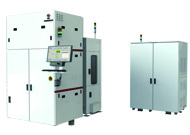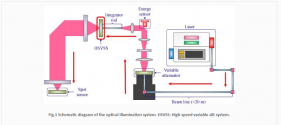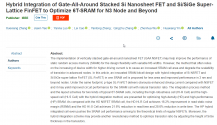If this overlay tool is going to be paired with their DUV immersion scanners then is irrefutable proof that they are aiming their scanners to reach ASML 2000i immersion scanner levels.Said to be pair with SSX800
SHM800 Holistic Metrology Equipment

SHM800
SHM800 holistic metrology equipment is an optical scatterometry-based system. SHM800 is mainly used in advanced process (55nm~7nm). It can offer the high precision overlay measurement, and has a throughput to match the productivity of lithography scanner. Working with the process control, SHM800 can improve the performance of scanner in overlay error control.
Product Features
Match the requirement of Logic, Memory, Dram and other advanced technology in overlay measurement.
High-speed measurement for a large number of sampling.
Compatible with micro-marking to meet advanced node In-die measurement.
Provide multi-dimensional adjustable configuration for different process layer stacks.
Provide automatic tools to optimize the measurement configuration.
Holistic lithography solutions to improve overlay performance.
You are using an out of date browser. It may not display this or other websites correctly.
You should upgrade or use an alternative browser.
You should upgrade or use an alternative browser.
Chinese semiconductor thread II
- Thread starter vincent
- Start date
It is better to buy than make. This statement is still haunting China's DUV. You keep nagging on and on about how long SMEE took to develop their DUVi machine. What you're missing is that for all that time, they were depending on western supply chains. For things like lasers and dual stage systems. All of those have been replaced with domestic alternatives. Things that didn't exist until a year ago or so.I already know that SMEE is separate from the EUV project. The problem is that SMEE has been a company since 2002, created for the sole purpose of developing lithography products, failed to develop any competitive products, and despite DUVi being a mature technology, still can't mass produce them despite the very real threat of ASML cutting China off of DUV exports, forcing China to stockpile tens of billions of ASML's DUVi machines.
This matters because it represents the state of the lithography development in China. It's a niche market and a large amount of the trained lithography experts and engineers in China would already be working in SMEE. Yeah, various different companies and institutions are working on EUV, but they're not magic. If they were, SMEE wouldn't be in this current state of limbo for the last 20 years. Don't forget that SMEE depends heavily on various suppliers, if the domestic chinese optics/mirrors/lasers suppliers are somehow good enough to suddenly make EUV systems, then SMEE won't be in such a wretched state for so many decades.
So what difference will all of this new companies/institutions make? If they are so good, why didn't they go help out SMEE in their development 10 years ago, or 6 years ago when the sanctions made the threat of even basic DUV machines being cut of very real? Producing a prototype is very different from mass production too. Again with the fighter analogy, if your 4th gen fighters can barely get off the ground, your entire aviation industry isn't magically gonna upgrade itself just because you got a bunch of different companies to develop your 5th gen fighter.
So what if they test a EUV machine in 2017? SMEE was in the market since 2002, trying it's best to develop a whole range of lithography products, failed to get market share or develop a competitive product and can't even get it's SSA800 into mass production when China needed it the most. Again, if all this chinese institutions like Tsinghua/Harbin had super geniuses who could develop the vastly more complicated EUV systems in a fraction of the time, SMEE wouldn't be struggling, they would have dominated the market from the get go.
So yeah, without the western supply chain, you're expecting them to mass produce with brand new just created supply lines?
Yes, it took a LOT longer than it should BECAUSE of the sanctions. It's that simple. EUV won't suffer the same fate simply from the fact that they're going all domestic from day one. This is also many of the fears on the C919 project comes from. Probably wasn't better to buy than to make.
There's been a lot of discussion about this but is this still the prevailing thought? There a lot for back and forth on this throughout the thread but I don't think this was the consensus.@sunnymaxi please consider that the business case for EUV is still far from being decided, even years later
The high NA machine may be hard to justify but I thought EUV is a worth while purchase for fabs?
looks like SMEC is partnering up with another firm 南京南瑞半导体 for making SiC. I assume it is fabbing for them
demand for SiC is just exploding, but so is competition
for Puxing electronics, SiC income is up 500%, 60% in electric drive
past year, looks like it produced 100k epitaxy wafers
2024 6-inch SiC production expecting to be 300k wafers, 80% in electric drive. 8-inch production expcting to be 10k, so just getting started
substrate cost can go down another 30%. Over 100 Sic companies in China, fierce competition
I understand your frustration but the fact of the matter is that, contrary to msm reporting, lithography is just not a super pressing constraint for China in the medium term. One machine can generate a lot of throughput, and China has a great many in stockpile. The need to replace other important front-end equipment is much more urgent and that is taking up most of the industry attention.I already know that SMEE is separate from the EUV project. The problem is that SMEE has been a company since 2002, created for the sole purpose of developing lithography products, failed to develop any competitive products, and despite DUVi being a mature technology, still can't mass produce them despite the very real threat of ASML cutting China off of DUV exports, forcing China to stockpile tens of billions of ASML's DUVi machines.
This matters because it represents the state of the lithography development in China. It's a niche market and a large amount of the trained lithography experts and engineers in China would already be working in SMEE. Yeah, various different companies and institutions are working on EUV, but they're not magic. If they were, SMEE wouldn't be in this current state of limbo for the last 20 years. Don't forget that SMEE depends heavily on various suppliers, if the domestic chinese optics/mirrors/lasers suppliers are somehow good enough to suddenly make EUV systems, then SMEE won't be in such a wretched state for so many decades.
So what difference will all of this new companies/institutions make? If they are so good, why didn't they go help out SMEE in their development 10 years ago, or 6 years ago when the sanctions made the threat of even basic DUV machines being cut of very real? Producing a prototype is very different from mass production too. Again with the fighter analogy, if your 4th gen fighters can barely get off the ground, your entire aviation industry isn't magically gonna upgrade itself just because you got a bunch of different companies to develop your 5th gen fighter.
So what if they test a EUV machine in 2017? SMEE was in the market since 2002, trying it's best to develop a whole range of lithography products, failed to get market share or develop a competitive product and can't even get it's SSA800 into mass production when China needed it the most. Again, if all this chinese institutions like Tsinghua/Harbin had super geniuses who could develop the vastly more complicated EUV systems in a fraction of the time, SMEE wouldn't be struggling, they would have dominated the market from the get go.
SMEE may not be as well funded or talented as the bunch of companies and institutions working on EUV but don't forget that SMEE has two decades of experience in lithography systems, has actual working lithography products and has been working on DUVi for more then a decade. The fact that they still can't mass produce cutting edge DUVi machines yet says a lot.
Don't forget that while EUV is nice, the mature nodes using DUV is still the backbone of the economy, it's more of priority for China to get domsetic DUVi then EUV.
Sure companies like Huawei is competent as hell, but it's still an area that they have no prior experince in and they only got roped in after 2018 after the sanctions dropped. The fact that DUVi is taking so long says a lot about how bumpy the road to EUV is. After all, SMEE depends on lots of vendors and suppliers that will no doubt also will contributing to the EUV project due to the similarity of some of the competents. How can you develop EUV so fast when the DUVi project and other lithography systems are so undeveloped? I bet that mountains of money and talent also poured into SMEE after 2018, surely the highers up in China recognised the threat of America getting ASML to stop DUV exports. And 6 years later, their SSA800 might finally go into mass production this year maybe? Not a good sign.
This things don't develop out of nowhere, you have to build the industry up. It's like a country trying to developing 5th gen fighters when their 4th gen fighter program can barely get off the ground. It's not impossible, but like DUVi machines, I think it's going to take a lot longer then what many people in this thread think.
Sorry, but you're not making any sense.
To use an crude analogy, there are hypersonic missiles, and cruise missiles.
Obviously, EUV is the hypersonics, and DUVi are the most advanced cruise missles.
Just because that someone knows how to make a cruise missile, means squat for making a hypersonic one.
It may look linear on a chart or timeline, but it is most definitely not in terms of engineering. No. No. No.
DUV and EUV are two separate things, two different paths of research and development, which seems we cannot get our heads around that.
Evaluation of measurement uncertainty of the high-speed variable-slit system based on the Monte Carlo method.
Abstract
This paper presents a dynamic and static error transfer model and uncertainty evaluation method for a high-speed variable-slit system based on a two- dimensional orthogonal double-layer air-floating guide rail structure. The motion accuracy of the scanning blade is affected by both the moving component it is attached to and the moving component of the following blade during high-speed motion. First, an error transfer model of the high-speed variable-slit system is established, and the influence coefficients are calculated for each source of error associated with the accuracy of the blade motion. Then, the maximum range of each error source is determined by simulation and experiment. Finally, the uncertainty of the blade displacement measurement is evaluated using the Monte Carlo method. The proposed model can evaluate the performance of the complex mechanical system and be used to guide the design.
Conclusions
The HSVSS is an important part of the optical illumination system. In this paper, an error transfer model of the HSVSS based on a double-layer two-dimensional orthogonal air-floating guide was established, and the influence of each source of error on the motion error of blade was analyzed. At the same time, the maximum range of every error source were obtained by simulation and experiment and the displacement uncertainty of the blades were evaluated by the MCM.
According to the results obtained using the proposed error transfer model, the installation error of the driving rail has the largest influence on the motion accuracy of the blades in the HSVSS. Therefore, errors should be minimized during the assembly process. Finally, based on the results of the dynamic error analysis, increasing the air gap stiffness of the air-floating guide rail can effectively improve the dynamic accuracy of the blade at high accelerations.


According to the results obtained using the proposed error transfer model, the installation error of the driving rail has the largest influence on the motion accuracy of the blades in the HSVSS. Therefore, errors should be minimized during the assembly process. Finally, based on the results of the dynamic error analysis, increasing the air gap stiffness of the air-floating guide rail can effectively improve the dynamic accuracy of the blade at high accelerations.



Instead for EUV the research institute / state academy approach makes perfectly sense: numbers will be forever low, EUV machines will be a limited sequence of "single units", investment will be huge, ROI non existent.
I don't see Chinese EUV machines being produced in single units.
Remember that Chinese smartphone production is still 60% of the global total.
Call it 840 million phones.
And prior to the sanctions, Huawei had already passed Apple and was on track to surpass Samsung to become the world's largest smartphone maker. We can see Huawei still have that same ambition, and in order to do so, they will need the latest semiconductors as they are more power-efficient.
So just like Apple has funded and driven TSMC's EUV efforts, we will see the same thing happen with Huawei and SMIC.
In addition, Huawei also makes AI chips, and we can see NVidia going with TSMC 4nm which is best served with EUV. The same applies to Intel and AMD who produce the latest CPUs, as Chinese companies will want to produce the latest CPUs as well. Ditto for memory as SK Hynix are starting to use EUV for some steps.
---
So if we look at ASML, they currently produce 50-60 EUV machines per year.
And in terms of the global landscape, China accounts for 25-30% of semiconductor consumption. That alone would suggest 15-20 EUV machines per year in China.
Another 25-30% of semiconductors go through Chinese factories, which suggests another 15-20 EUV machines annually are up for grabs.
So a Chinese EUV machine won't be a limited sequence production run in the single digits.
---
It looks like ASML is working to a 100% profit margin ie. selling them for twice what they cost.
If each EUV machine is sold for $200 Mn+, that's $7Bn+ in revenue.
And half of that is profit.
---
Then contrast that with a guestimate from Asianometry that a Chinese EUV effort might cost $1 Bn annually for 10-15 years.
So a napkin calculation would have Chinese EUV development costing $10-15 Bn
Even if they only make 20 per year, that's a profit of $2 Bn annually. So that's $20 Bn over the next 10 years which makes it a profitable project.
And if they end up producing 40+ per year, you can easily see that a Chinese EUV project would be wildly profitable.
---
And this is just based on today's production levels of EUV machines by ASML.
I fully expect output to be much higher in 10 years
Last edited:

